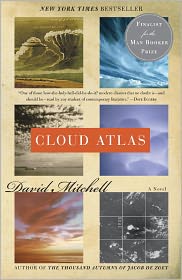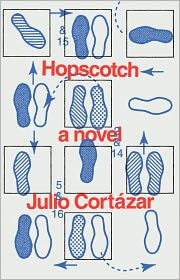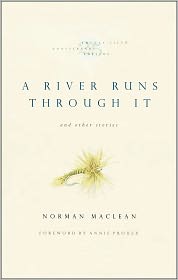Five Novels that Play with Time
In Stanley Kubrick’s film adaptation of The Shining, by Stephen King, the director uses time title cards to disrupt the viewer’s sense of time. The text on the cards initially seems very specific and designed to ground the viewer in the timeline, but by the time the word MONDAY flashes on the screen midway through it hits you: as the cards become more specific, they also have less relation to anything, becoming meaningless and disorienting.
Novels often play with time as well—most commonly by telling a story out of order. And while many classic, brilliant novels have been written using that technique, some go beyond, manipulating the reader’s sense of time in ways both subtle and obvious in order to control their perception of how it works in the story, altering the reading experience. Here are five examples of time manipulation in novels that will blow your mind.
Cloud Atlas
Cloud Atlas
In Stock Online
Paperback $19.00
Cloud Atlas, by David Mitchell
Mitchel’s novel has a unique structure in which six stories are linked to each other by virtue of the protagonist of one story reading or hearing the next. Each story ends abruptly about halfway through, and the next story begins. After the sixth beginning is told, the stories are concluded, one by one, in the second half of the book. All of this is not simply to confuse or inject the book with a false complexity, however; one of the fundamental themes of the book is that human nature is universal, and people are doomed (or blessed) to repeat themselves. The structure Mitchel created underscores this, telling the stories as if they were part of a unified whole instead of separate tales of separate people.
Cloud Atlas, by David Mitchell
Mitchel’s novel has a unique structure in which six stories are linked to each other by virtue of the protagonist of one story reading or hearing the next. Each story ends abruptly about halfway through, and the next story begins. After the sixth beginning is told, the stories are concluded, one by one, in the second half of the book. All of this is not simply to confuse or inject the book with a false complexity, however; one of the fundamental themes of the book is that human nature is universal, and people are doomed (or blessed) to repeat themselves. The structure Mitchel created underscores this, telling the stories as if they were part of a unified whole instead of separate tales of separate people.
Catch-22
Catch-22
By
Joseph Heller
Introduction
Christopher Buckley
In Stock Online
Paperback $19.99
Catch-22, by Joseph Heller
Catch-22, a novel about Air Force airmen trying to survive World War II, derives much of its storytelling muscle from its jumpy, omniscient point of view, which visits several moments in the collective story from different points of view and with various time shifts, each time revealing something new. The effect forces the reader to be initially as confused and frustrated by the story as the characters are by the military, the war, and life itself. Slowly, both the reader and the characters come to accommodations that let them survive and even appreciate what they are experiencing, and the parallel experiences are what make this novel more than the sum of its hilarious parts.
Catch-22, by Joseph Heller
Catch-22, a novel about Air Force airmen trying to survive World War II, derives much of its storytelling muscle from its jumpy, omniscient point of view, which visits several moments in the collective story from different points of view and with various time shifts, each time revealing something new. The effect forces the reader to be initially as confused and frustrated by the story as the characters are by the military, the war, and life itself. Slowly, both the reader and the characters come to accommodations that let them survive and even appreciate what they are experiencing, and the parallel experiences are what make this novel more than the sum of its hilarious parts.
Hopscotch: A Novel
Hopscotch: A Novel
In Stock Online
Paperback $20.00
Hopscotch, by Julio Cortázar
We are all likely familiar with the concept of the unreliable narrator, but in this book Cortázar takes on the role of unreliable author. A novel of 155 chapters designed to be read in any order—either one of the two orders Cortázar himself offers, or randomly—it manages to both make sense and tell a story. Cortázar even suggests that the final 99 chapters aren’t even necessary and can be skipped entirely. The effect is astoundingly freeing for the reader. The story of Horacio Oliveira’s search for his lover, La Maga, and the twisting, serpentine path it takes him on is perfectly suited to this remarkable and challenging book.
Hopscotch, by Julio Cortázar
We are all likely familiar with the concept of the unreliable narrator, but in this book Cortázar takes on the role of unreliable author. A novel of 155 chapters designed to be read in any order—either one of the two orders Cortázar himself offers, or randomly—it manages to both make sense and tell a story. Cortázar even suggests that the final 99 chapters aren’t even necessary and can be skipped entirely. The effect is astoundingly freeing for the reader. The story of Horacio Oliveira’s search for his lover, La Maga, and the twisting, serpentine path it takes him on is perfectly suited to this remarkable and challenging book.
Infinite Jest
Infinite Jest
In Stock Online
Paperback $24.99
Infinite Jest, by David Foster Wallace
Using a trick similar to Kubrick’s, one of Wallace’s ideas in Infinite Jest is that time is given corporate sponsorship in an unspecified future—instead of a numeric year, we have, say, the Year of Glad (as in the garbage bags). The story twists and turns through a timeline that makes perfect sense if mapped—but that mapping is difficult and slippery, because we don’t know the chronological order of the years mentioned. While some order can be gleaned from the text, a layer of surrealism is added to the story, as events that initially seem to happen at one point actually occur at another, alternately clarifying and obscuring as you read on.
Infinite Jest, by David Foster Wallace
Using a trick similar to Kubrick’s, one of Wallace’s ideas in Infinite Jest is that time is given corporate sponsorship in an unspecified future—instead of a numeric year, we have, say, the Year of Glad (as in the garbage bags). The story twists and turns through a timeline that makes perfect sense if mapped—but that mapping is difficult and slippery, because we don’t know the chronological order of the years mentioned. While some order can be gleaned from the text, a layer of surrealism is added to the story, as events that initially seem to happen at one point actually occur at another, alternately clarifying and obscuring as you read on.
A River Runs through It and Other Stories (Twenty-fifth Anniversary Edition)
A River Runs through It and Other Stories (Twenty-fifth Anniversary Edition)
By
Norman Maclean
Foreword by
Annie Proulx
Paperback $12.00
A River Runs Through It, by Norman Maclean
Maclean’s amazing novel dispenses with a traditional novel structure and reads more like a confessional infodump directly from the author’s brain. While ostensibly told in a straightforward chronological order, in reality the story about Maclean’s life in Montana, his father and deceased brother, and, of course, fly fishing is told by jumping from memory to memory in a naturalistic way that mimics how we actually remember our own lives. The effect is subtle and brilliant, and is one big reason anyone who reads this remarkable short novel is affected powerfully by it.
Shop all fiction >
A River Runs Through It, by Norman Maclean
Maclean’s amazing novel dispenses with a traditional novel structure and reads more like a confessional infodump directly from the author’s brain. While ostensibly told in a straightforward chronological order, in reality the story about Maclean’s life in Montana, his father and deceased brother, and, of course, fly fishing is told by jumping from memory to memory in a naturalistic way that mimics how we actually remember our own lives. The effect is subtle and brilliant, and is one big reason anyone who reads this remarkable short novel is affected powerfully by it.
Shop all fiction >




